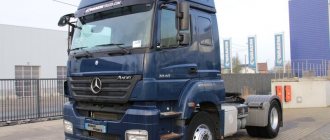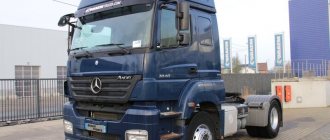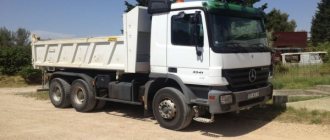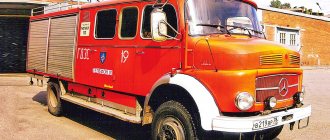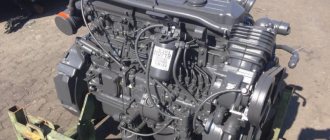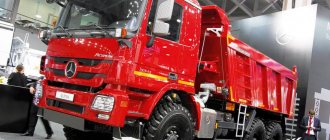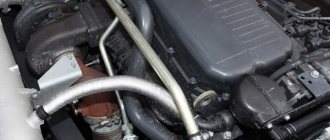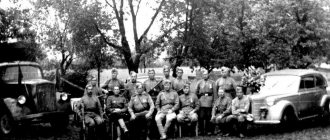Mercedes-Benz Axor
The Mercedes-Benz Axor model program, starting with a version with a gross weight of 18 tons, has become more diverse, which has made it possible to significantly expand the range of applications for this truck compared to the previous model range, which included only truck tractors.
In addition to the already well-known two-axle truck tractors (4x2), this vehicle family now also includes heavy vehicles without trailers: two-axle (4x2 and 4x4) with a total weight of 18 tons and three-axle vehicles with a total weight of 26 tons (6x2 and 6 ×4). The appearance of the new Mercedes-Benz Axor fits perfectly into the overall style of Mercedes-Benz trucks.
The same can be said about the interior. The dashboard, instrument cluster, switches and buttons, upholstery and materials - everything is new here. The customer can choose from three cab versions, equipped depending on the vehicle’s application.
The frame, borrowed from the Mercedes-Benz Actros and specially adapted to the characteristics of the Axor, meets all the requirements for heavy delivery trucks and Mercedes-Benz truck tractors. Trucks are equipped with engines of the OM 900 series with a displacement of 6.4 l and 7.2 l, as well as the OM 457 LA series with a displacement of 12.0 l. The engines of the OM 906 LA series produce 170 kW (231 hp) and 205 kW (279 hp). The largest OM 926 LA has an output of 240 kW (326 hp). The most powerful version has a maximum torque of 2100 Nm.
Modern systems on board the Mercedes-Benz Axor ensure long service intervals, up to 100,000 km for long-distance cargo transportation.
Technical characteristics of Mercedes Axor
The homeland of the Mercedes Axor is Turkey, but development was also carried out in Brazil, and after its completion, production was established in other countries, including Germany. The Russian history of the brand has its own milestones: the appearance of a budget version in 2003 and a cooperation agreement between Mercedes and KamAZ, according to which a hybrid will appear starting in 2014, having a cab from the Mercedes Axor and a KamAZ platform.
Along the way, at the request of Russian construction companies, German engineers created a four-axle Mercedes Axor dump truck. However, sales in Russia still do not please Mercedes marketers - 300-400 units of equipment per year. On the other hand, Axor sells well in Russia with mileage. Used Axor trucks sell well among Russian cargo carriers, which is due to the inherent problems of the Mercedes Axor tractor, which require some running-in and adjustment.
The German development can be adapted for almost any purpose, but despite this potential, the Mercedes Axor dump truck appeared on the market relatively recently.
Disadvantages of Mercedes Axor
- Lack of heaters as standard - warming up the crankcase in the cold is difficult and requires the owner to put in the effort to install the appropriate systems or a lot of patience.
- Inconsistencies with Russian fuel - there should be no water in diesel fuel, and sulfur should be contained in a minimum amount. The solution is to install the add-on yourself. filter.
- Reviews of the Mercedes Axor speak of the unreliability of the original axle seals - rapid wear and all that it entails.
- Not the best automatic transmission for Russian roads - unstable behavior at the start and ascent. At the same time, for the main gear of the automatic transmission, you can choose only one of two gear ratios - 2.38 and 3.08. As a result, the Axor's fuel consumption is far from optimal, especially in difficult terrain.
- Fixed front longitudinal rod end - failure requires replacement of the entire part. This feature of most European tractors, including competitors from Volvo Trucks, does not make the car more beautiful.
- High cost of original parts. As a result, most used trucks contain non-original elements.
The southern origin of Mercedes Axor is confirmed by its constant participation and victories in the famous truck race - Formula Truck. The main stages of the competition take place in Brazil.
Advantages
First of all, it is a wide and interesting range of engines. All modern models, including the Mercedes-Benz Axor 1835, use the same engine - the OM 457LA - but this Iran Khodro Diesel Company-certified development has a variety of power settings. The Axor diesel is a 6-cylinder in-line 4-stroke engine, water-cooled. The use of an in-line cylinder arrangement is caused by an attempt to save fuel and lubricants, the success of which is evidenced by reviews of the Mercedes Axor.
All new Mercedes Axor 1835-2543 engines are equipped with the BlueTec system. This original development by German engineers allows powerful diesel engines to reduce fuel consumption and pass standards (up to the upcoming Euro-6) without engine modifications. The BlueTec catalytic converter is a heat-resistant chamber in which a special catalyst oxidizes toxic gases NOx, CO, CH, turning them into nitrogen, carbon dioxide and water.
The cylinder block is cast, made of aluminum alloy, i.e. The cylinder head is a single element for all cylinders. Direct injection method - BoschPES. The crankshaft, which transmits the rotation further, is a high-precision forged element sitting on seven three-layer bearings. The structure is balanced by counterweights, which allows stabilizing engine operation. Without a significant increase in fuel consumption and reaches maximum Newton meters already at 1100 min−1. Depending on the engine type, the torque can take values from the range of 1200-2250 Nm.
Advantages and disadvantages
Mercedes-Benz Axor has significant advantages in the following points:
- The use of BlueTec technology and compliance with Euro 5 standards not only gives priority to entry into cities. But it will also help in the near future to avoid paying significant amounts in the form of taxes and fees for damage caused to the environment of Europe. There will also be no problems when updating the fleet of vehicles, and proceeds from the sale of used trucks will offset part of the costs of purchasing new ones.
- Economical. Up to 5% fuel savings due to innovations in the combustion process and up to 20% due to increased service intervals.
- Wide range of engines with proven BlueTec technology, ranging from 129 HP to 598 HP.
- A reliable gearbox is a 12-speed Power-Shift automatic with a tunnel crankcase, weighing half a centner less than a 16-speed Telligent gearshift transmission and 40 kg less than a 9-speed manual transmission.
In addition to the generally recognized disadvantage of budget versions of the Mercedes-Benz Axor, which do not have sleeping places, these trucks, according to reviews from owners, with whom reviews from drivers coincide, have some other disadvantages:
- For the construction industry, the absence of a 4-axle vehicle in the Mercedes-Benz Axor tractor model range is sensitive, since not every special body can be installed on a 3-axle chassis.
- Many people think that the side members, 7.5 mm thick, are too thin for the Mercedes-Benz Axor truck tractor, because even the budget Scania Griffin has almost 1 cm.
- The bearing in the generator gets stuck too often. True, increasing its power to 100 amperes puts everything in its place.
Cabin. Execution options
The exterior design of the Mercedes-Benz Axor cabin clearly demonstrates the unity of beautiful form and functionality that is characteristic of all Mercedes-Benz commercial vehicles. Regardless of the selected cab type, the headlights and bumper design are the same for all Axor versions. The Mercedes-Benz Axor truck is equipped with headlights with today's popular transparent glass lenses, which combine an attractive design with optimal lighting performance. Xenon headlights can be ordered upon request.
When driving, the driver will be able to appreciate the improved visibility of the Mercedes-Benz Axor, provided by the advanced mirror system. Speaking about the safety provided by the improved all-round visibility of the vehicle, it is worth recalling once again the protection of the side windows from dirt, which is provided by the improved fairings located on the front of the truck.
In the cabin of the Mercedes-Benz Axor, the driver and passenger will find completely new work areas. The Mercedes-Benz Axor truck offers a large selection of cab sizes. Depending on the application and engine installed, you can choose from a standard cab (S), a standard cab with a 180mm extension, a long cab (L) and a long cab with a high roof. The interior height of this most spacious cabin is 1,910 mm. For Axor versions with a 12-liter engine, the engine tunnel in the cabin is now 120 mm lower.
There is a choice of three options for finishing the front panel of the cabin, depending on the intended application.
We can safely say that in the new version, the Axor cabin in terms of comfort and ergonomics is as close as possible to the cabin of Actros cars that has already received universal recognition.
Exterior
Everything is done for intensive work and good rest. Mercedes-Benz Axor has 5 cab options:
- Short (S) just over one and a half meters.
- Extended - 1.8 m.
- With one sleeping place - more than 2.2 m.
- With sleeping places for two people.
- The L cab with a high roof - increased comfort, with easy entry, spacious compartments and shelves for various things - is a truck driver’s “dream”.
Adequate levels of safety are ensured by excellent performance of Telligent brakes, clear glass headlights and side mirrors that keep blind spots to a minimum, as well as active safety devices.
Engine and transmission
Under the cabin of the Mercedes-Benz Axor there are three basic versions of six-cylinder engines with three different displacements. The six-cylinder engine of the OM 906 LA series is available with a displacement of 6.37 liters. It produces 170 kW (231 hp) and 205 kW (279 hp). The maximum torque is 810 and 1,100 Nm, respectively. New to the Mercedes-Benz Axor engine range is a version of the six-cylinder OM 926 LA with an increased displacement of 7.20 liters. Its power is 240 kW (326 hp) and its maximum torque is 1300 Nm. The Mercedes-Benz Axor, equipped with a 12-liter OM 457 LA engine and having a gross train weight of 40 tons, is intended for use as a heavy distribution tractor and long-distance cargo transportation. Powerful and economical, it is available in three power classes: 315 kW (428 hp), 295 kW (401 hp) and 260 kW (354 hp), plus Euro 4 and 5 engines.
Depending on the engine installed, Mercedes-Benz Axor trucks are equipped with a six-, nine- or 16-speed Mercedes-Benz manual transmission. Instead of the 12-speed front-gear transmission previously found on the Axor, a completely new nine-speed G 131-9 gearbox is installed, which weighs 30 kg less.
For the Axor with a 12-liter engine, Mercedes-Benz offers the optimal 9-speed gearbox G 221-9 - eight main gears and one low gear. A wide range of gear ratios from 16.2 to 1.0 covers all gears up to ninth, that is, from crawler to eighth gear. The air-mechanical gearshift drive, presented in the well-known double-H shift pattern, allows any Axor driver to intuitively select the correct gear without hesitation.
The Mercedes-Benz Axor is also offered with a 16-speed transmission. This is a G 211-16 with direct drive (highest gear ratio 1:1). The G 240-16 version with two overdrive gears is available as an option for the Axor with the 12-litre engine in combination with the HL7 rear axle.
The wide range of transmission options available in combination with powerful rear axles allows you to select a drive system that optimally matches the profile of the tasks being performed.
Advantages
First of all, it is a wide and interesting range of engines. All modern models, including the Mercedes-Benz Axor 1835, use the same engine - the OM 457LA - but this Iran Khodro Diesel Company-certified development has a variety of power settings. The Axor diesel is a 6-cylinder in-line 4-stroke engine, water-cooled. The use of an in-line cylinder arrangement is caused by an attempt to save fuel and lubricants, the success of which is evidenced by reviews of the Mercedes Axor.
All new Mercedes Axor 1835-2543 engines are equipped with the BlueTec system. This original development by German engineers allows powerful diesel engines to reduce fuel consumption and pass standards (up to the upcoming Euro-6) without engine modifications. The BlueTec catalytic converter is a heat-resistant chamber in which a special catalyst oxidizes toxic gases NOx, CO, CH, turning them into nitrogen, carbon dioxide and water.
The cylinder block is cast, made of aluminum alloy, i.e. The cylinder head is a single element for all cylinders. Direct injection method - BoschPES. The crankshaft, which transmits the rotation further, is a high-precision forged element sitting on seven three-layer bearings. The structure is balanced by counterweights, which allows stabilizing engine operation. Without a significant increase in fuel consumption and reaches maximum Newton meters already at 1100 min−1. Depending on the engine type, the torque can take values from the range of 1200-2250 Nm.
In the photo of the Mercedes Axor, the cabin seems narrow, in reality everything is not so sad, but there are complaints about the lack of space.
- Compared to competitors with the same payload capacity, the Mercedes Axor wins by weight by several hundred kg (the Axor wins 250 kg even over another Mercedes model, the Actros).
- The lack of choice of main gear is compensated for by 6, 9 and even 16-speed gearboxes, each of which is equipped with a tunnel housing.
- The ABS system is unlikely to surprise anyone these days, but Telligent disc brakes work in tandem with it on the Mercedes Axor.
- Precise on-board electronics.
- All models, including the Axor 1840 LS, have a single axle with a hypoid main gear (higher load, quieter, smoother running).
Chassis
The frame, borrowed from the Mercedes-Benz Actros and specially adapted to the characteristics of the Axor, meets all the requirements for heavy distribution tractors, long-haul trucks carrying out domestic transportation and, of course, vehicles operating in the construction and public utilities sector. It is designed to withstand high loads and was designed using systems and CAD calculations using the finite element method. Despite its low weight, the frame meets the highest requirements in terms of flexural and torsional rigidity. Standard perforations for fastening crossbars and components are part of the process of unifying the design of vehicles.
All versions of the Mercedes-Benz Axor with leaf spring suspensions are equipped with parabolic springs. The standard shock absorbers and stabilizers are specially adapted to parabolic springs. The leaf spring suspension is mounted using maintenance-free rubber bearings that incorporate synthetic molecular components and therefore require neither central nor manual lubrication.
Various versions of the Mercedes-Benz Axor can be equipped with air suspension. In addition to leaf/air springs, fully air suspensions are also available. The air suspension provides precise axle control and excellent dynamic properties. The use of the Stabilenker device, which combines the functions of a guide system and a stabilizer, reduces weight and increases stability.
Mercedes-Benz Axors with air suspension are equipped as standard with the Telligent frame height adjustment system, which ensures easy raising and lowering of the frame.
Electronic control of the braking process provides the Axor truck with comfortable braking like a car, regardless of the load level. The brake pedal travel ensures constant deceleration of the vehicle or the entire road train, regardless of the load level.
Thanks to the high proportion of maintenance-free or maintenance-free components, service costs have been significantly reduced.
Interior
In the Mercedes-Benz Axor, the cabin is not much inferior to many Mercedes models in terms of its level of finishing and comfort. But it is distinguished by strict thoughtfulness and ergonomics. The basic kit includes a seat with air suspension.
The “Razvoznoy” interior option provides the opportunity to:
- Convenient movement inside the cabin to the nearby lower berth.
- Middle seat settings for third person.
- Equipped places for storing documents and similar important things.
- All important control points for systems not directly related to driving (heating, ventilation, etc.) are within close reach.
The “Comfort” interior option provides the opportunity to:
- Larger storage compartment under the dashboard.
- Pleasant to the touch “dashboard” finish.
- There are many possibilities for adjusting the positions of the seats, ventilation and heating with heat dissipation in the right places.
- Inclusion of anti-vibration elements in the cabin mount.
The cabin has a durable 2-point suspension. Which undoubtedly does not provide additional comfort, but it is more reliable and durable. To raise the cabin, you need to turn on the hydraulics by raising the corresponding flag and not twist, but swing the lever. Tuning of the cabin interior “little by little” is done by the drivers themselves.
External inspection
When we first saw the Axor, we were surprised: the Actros “big brother” standing next to it with a medium-height cabin seemed somehow small. And this despite the fact that the Axor is equipped with a cabin from the “medium-duty” Atego. It turns out that on the Axor 1840 version it is simply located high, and in general the cabin is narrower than that of the Actros (2280 versus 2449 mm), but longer (2250 and 2200 mm, respectively). Its characteristic external difference is the developed wings above the wheels.
The front suspension is the most common, spring type - simple, reliable, cheap. Rear – pneumatic, four-point. The rear axle is connected to the frame by a triangular structure, on the tops of which silent blocks are installed (one of them is mounted on the gearbox housing, and the other two are on the frame). The function of the turntable stabilizer is performed by a device that redistributes air between the cylinders so that the platform of this circle always remains in a horizontal position.
Fuel tanks, battery and tool boxes are locked with a key - you can’t just open them. But you can get to the engine only after a five-minute charge - working with the hydraulic manual cabin lift requires considerable effort.
Much attention is paid to safety issues affecting other road users. How many accidents have occurred because the truck in front raises a lot of small splashes, forming a “fog” behind which you cannot see what is happening on the road. The designers of Axor, like Actros, solved this problem quite effectively. The mudguards have ribbed grooves. Now the water does not turn into small splashes, but is compacted in the grooves and drains to the ground.
Let's get into the cockpit
The steps and handrails for entering the cabin are very convenient. But the door does not swing wide enough, and you have to lean away from it to the side, touching the side of the strongly protruding wheel fender.
The cabin lacked not only climate control, but also air conditioning. They are installed only for an additional fee. But what pleased me was the air heater with a system for automatically maintaining the set temperature.
The driver's seat can be adjusted in several planes. The position of the steering column is fixed by a pneumoelectric lock. With a slight movement of his hand, he pressed the button, adjusted the steering column, and then pressed it again - and it locked in the selected position.
The right rear view mirror and right window lift are controlled electrically. But on the “driver’s” side, all manipulations have to be performed manually, without electrical or pneumatic assistants. Well, saving is saving! A full power package, like on the Actros, is available for an additional fee.
The protruding engine tunnel, covered with leatherette that is pleasant to the touch, practically does not interfere. I was pleasantly surprised by the large number of compartments for all sorts of little things. Three large compartments are located above the windshield, two are under the lower bunk. By the way, under the shelf there is a retractable plastic box, under the lid of which we found a portable flashlight mounted on a tripod.
Telligent® System
The main meaning behind the name Telligent® is that various electronic functions in the vehicle are provided through a special electronic communication system. Via a standard CAN data bus, the Telligent® system records, processes, monitors, controls and, if necessary, displays data on the instrument panel display.
Control signals are transmitted in fractions of a second to the relevant components, such as the engine, gear shift control, brake or other auxiliary systems. Telligent® monitors the data flow and ensures that all vehicle functions are performed optimally.
Telligent® systems provide vehicle reliability and minimize stress on transmission components and other systems. For example, the Telligent® engine management system constantly provides information on all the important parameters required for efficient engine control. The Telligent® gearshift system reduces the driver's effort to change gears to a minimum. The Telligent® braking system provides the fastest possible deceleration.
The Telligent® principle is thus used in almost all vehicle systems - engine management system, cruise control, air suspension control, anti-theft system, gear shift system, brake system, programmable module, navigation systems, maintenance system, various security systems. Most of these systems are installed as standard, others are available as options, depending on need.
